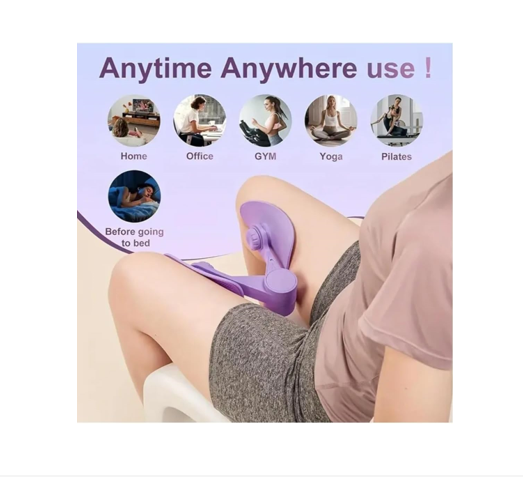Today’s best compact pelvic floor exercisers offer an easy, discreet and effective way to strengthen your core and improve bladder control from home.
These small but powerful tools are designed for convenience, comfort and targeted results, making them ideal for busy individuals, beginners, postpartum recovery or anyone looking to tone and support their pelvic muscles.
In this guide, we break down the best compact options to help you choose the right device for your goals.
What Is A Pelvic Floor Exerciser
A pelvic floor exerciser is a device designed to strengthen the muscles of the pelvic floor, which support the bladder, uterus and bowel.
These exercisers can be manual, electronic or app-connected and help improve bladder control, reduce incontinence, enhance core stability and support postpartum recovery.
They work by guiding or providing resistance for Kegel exercises, ensuring the correct muscles are engaged.
Some advanced models provide biofeedback or real-time tracking to monitor muscle contractions, making training more effective and helping users track progress over time.
What To Consider When Buying Best Compact Pelvic Floor Exercisers
Consider the following;
-
Size & Portability
A compact trainer is only useful if it’s actually easy to carry and store — look for small, lightweight designs and consider whether you want a device that fits in your bedside drawer, a gym bag or a travel pouch.
-
Type of Feedback / Training Mode
Biofeedback devices (with sensors) help ensure you’re contracting correctly while manual resistance trainers give strength via physical tension, but without real‑time feedback i.e. you rely on feel.
For beginners, a device with guided “modes” (timed vs free training) can help you stick to a proper routine.
-
Resistance or Intensity Levels
Adjustable resistance (mechanical or electronic) lets you scale up as your pelvic muscles grow stronger. If it’s an EMS or stimulation-based trainer, check how many intensity levels it offers and how finely you can adjust them.
-
Material Safety & Hygiene
Choose body-safe materials like medical-grade silicone or BPA‑free plastics to avoid irritation. The device should be easy to clean: non-porous surfaces and a design that resists bacteria, also consider whether it comes with a pouch or case.
-
Power & Battery Life (if Electronic)
For compact trainers, battery longevity is key — nobody wants to be charging every day. Check whether the device uses replaceable batteries or has a built-in rechargeable one.
-
App Connectivity & Smart Features
If you like guided workouts or want to track progress, look for a trainer that pairs with a smartphone app. Make sure the app is reliable, easy to use, and offers routines suitable for your goals (incontinence, postpartum, strengthening).
-
Safety & Certifications
For EMS or stimulation devices, check for FDA clearance or other medical certifications. Make sure the device is clinically reviewed or recommended by pelvic‑floor professionals.
-
Ease of Use & Comfort
A compact trainer should be ergonomic enough for insertion (if internal) or comfortable to use externally. Guidebooks, user-friendly controls, and intuitive designs make consistent use more likely.
-
Cost & Long-Term Value
Consider not just the upfront cost, but any recurring expenses (e.g., replacement probes, app subscriptions).
-
Contraindications & Professional Guidance
If you have pelvic pain, a hypertonic pelvic floor or other pelvic health issues, talk to a pelvic floor therapist before buying. Some devices (like Kegel weights) may not be suitable.
Make sure whatever you choose supports safe, guided use so that you don’t strain or misuse the muscles.
Best Compact Pelvic Floor Exercisers
1. Perifit Care + Pelvic Floor Exerciser
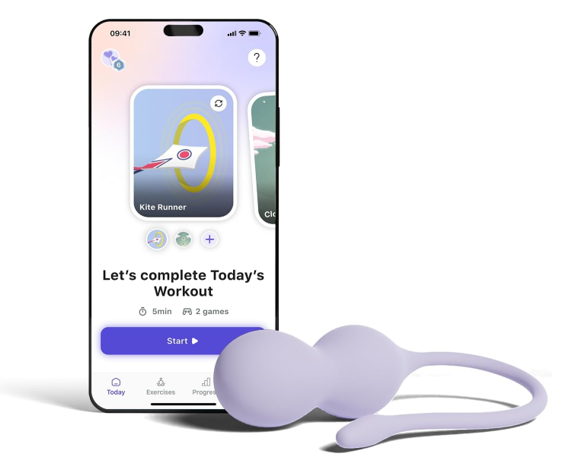
The Perifit Care+ is a smart, app-controlled Kegel trainer designed to help you strengthen your pelvic floor, improve bladder control and reduce urinary leaks all from the comfort of your home.
With real-time feedback, interactive games and a clinically backed design, it’s built to make pelvic floor exercises engaging and effective.
Features
- Motion detection
- FDA-cleared device
- Dual-sensor biofeedback
- More than 20 interactive games
- 5d performance tracking
- Flexible and compact design
- 100-day trial & FSA/HSA eligible
- Bluetooth low energy (BLE) for connectivity
Pros
- Long-life internal battery
- Offers real-time biofeedback
- FDA clearance adds trust and safety.
- Gamified experience makes training fun
- Risk reduction helps prevent improper technique
- Performance metrics help you track improvement over time.
- Ability to train in different positions thanks to motion detection.
Cons
- Not designed for everyone
- Non-rechargeable battery
2. Yarlap® with AutoKegel® | FDA Cleared Pelvic Floor Trainer

The Yarlap with AutoKegel is an FDA-cleared, medical-grade pelvic floor stimulator that automates Kegel exercises to help strengthen your pelvic floor muscles while potentially reducing urinary leaks and improving bladder control.
Designed in the USA and manufactured in the UK, it offers a “hands-free” 20-minute workout, making pelvic exercise both easy and effective.
Features
- AutoKegel technology
- Six preset programs
- Five-year warranty
- A PC stimulator
- FDA clearance
- A 9V battery
- Six modes
- FSA / HSA eligible
- Medical-grade materials
- A backlit control unit
Pros
- It is easy to use
- Only 20 minutes per session
- It is safe and reliable
- Comes in a travel-friendly case
- Offers hands-free pelvic training
- Comes with clinically designed programs
- Durable, with a 5-year warranty and FSA/HSA eligibility
Cons
- Designed for women only
- Requires cleaning after each use
3. Perifit – Pelvic Floor Exerciser with App
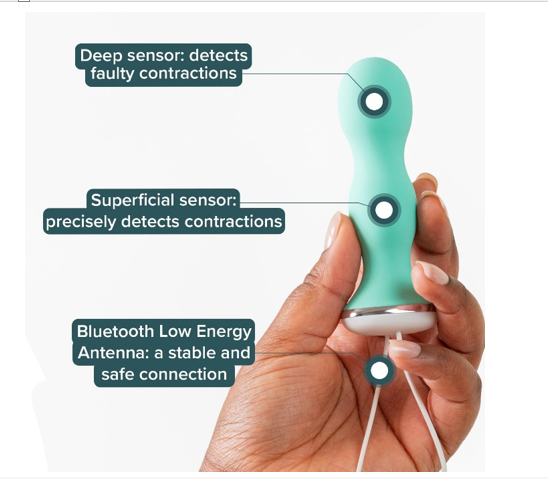
Another Perifit pelvic floor exerciser makes it to the list. It is a smart, Bluetooth-enabled Kegel trainer that connects to a mobile app to make pelvic floor workouts interactive, accurate, and fun.
It gives real-time feedback so you can strengthen your pelvic muscles correctly hence boosting bladder control, incontinence recovery and overall pelvic health.
Features
- Dual biofeedback sensors
- Interactive app
- Medical-grade materials
- 100-day return policy
- Long-lasting internal battery
- Progress tracking in 5 dimensions
- Real-time contraction monitoring
- Water-resistant silicone probe
Pros
- It is comfortable and durable
- Comes with great customer support
- You can track multiple performance metrics
- Dual sensors help you perform exercises correctly
- The app’s video games make Kegels fun and engaging
- Reminders, game achievements, and community features keep you motivated
Cons
- Not for everyone
- Battery non-replaceable
4. Generic Adjustable Pelvic Floor Exerciser
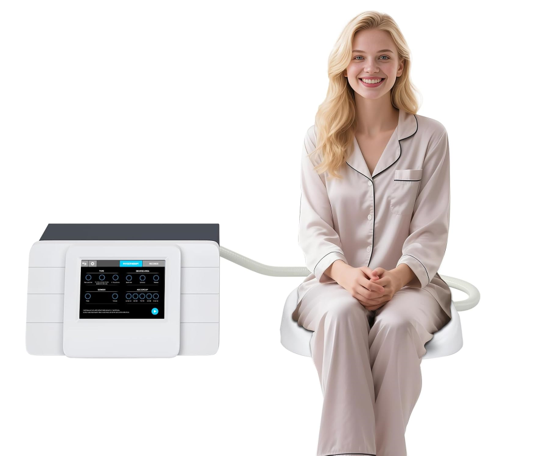
This adjustable pelvic floor exerciser from Generic is designed for both men and women who want a portable, at-home solution to strengthen their pelvic floor muscles.
With a resistance knob, it allows you to increase or decrease tension, making it useful for beginners and more advanced users alike.
It’s especially helpful for improving bladder control and supporting muscle recovery.
Features
- Adjustable resistance
- Dual-use design
- Touch screen control type
- Manual operation mode
- Corded electric power source
Pros
- Allows customizable workout
- Suitable for both sexes
- No batteries or app needed
- Non-invasive & effortless use
- Eco-friendly & skin-safe design
- Ideal for muscle recovery or incontinence training.
- Once bought, no need to keep buying disposable devices.
- Provides external resistance to make Kegel-type contractions more effective.
Cons
- Not pocket-sized
- No biofeedback
5. Intimate Rose Kegel Exercise System
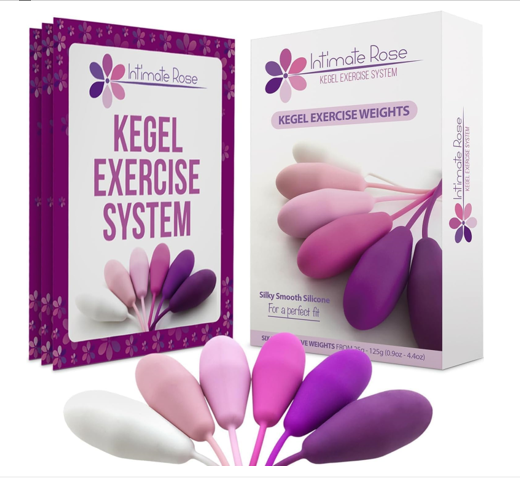
The Kegel exercise system from Intimate Rose offers a simple but effective way to strengthen your pelvic floor muscles using progressive resistance weights.
Designed for both beginners and advanced users, this set helps improve bladder control, support recovery (e.g. postpartum) and boost pelvic strength all with natural feedback and no electronics.
Features
- Silicone material
- Natural biofeedback
- Measures 6 x 4 x 2 inches
- Six progressive weights
- Ergonomic design
- Training kit included
Pros
- Compact and discreet
- Doctor-recommended model
- Offers progressive training
- Easy to carry and use anywhere
- No charging or app required.
- A one-time buy for long-term use.
- Quiet, manual design is simple and low-maintenance.
- Medical-grade silicone is hypoallergenic and easy to clean.
Cons
- Not for everyone
- Not suitable for hypertonic pelvic floor
6. Pelvifine Pelvic Muscle Trainer for Kegel Exerciser
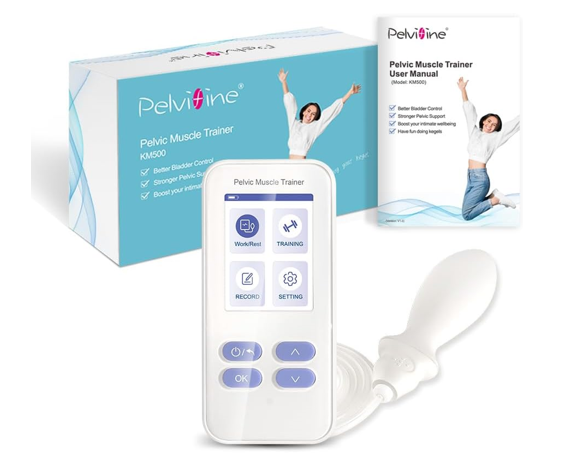
The Pelvifine pelvic muscle trainer with inflatable sensor probe is a biofeedback Kegel device that uses a soft, inflatable probe to measure pelvic floor strength.
By gently inflating inside, it provides real-time feedback (via a “Squeeze Scale”) and interactive exercise modes which is all designed to help you build pelvic muscle strength, improve bladder control and reduce incontinence with just 5–10 minutes of use per day.
Features
- Inflatable sensor probe
- 3 Kegel programs + a work/rest mode
- Real-time biofeedback
- Any-position training
- Runs on AAA batteries
Pros
- Offers accurate feedback
- It is a comfortable fit
- Quick workouts sessions
- No complex maintenance
- Scores help you monitor progress and stay motivated.
Cons
- Battery Cost
- It may take a few sessions to get used to inflating
7. Husyop Pelvic Floor Exercise Devices
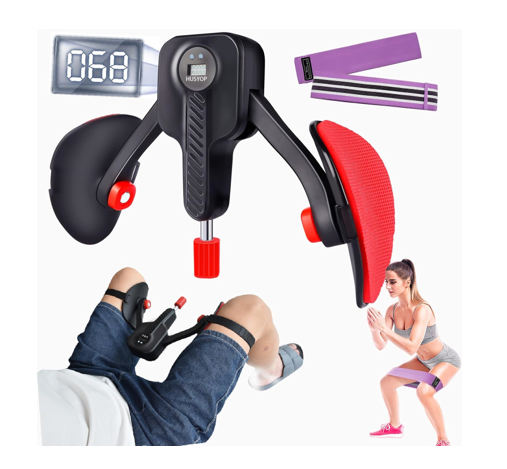
This Husyop Kegel exercise and thigh trainer is a powerful, adjustable-resistance device that combines pelvic floor strengthening with inner-thigh training.
Built for both men and women, it uses high-resistance springs and padded leg straps to help improve pelvic control, tighten the inner thighs and support better bladder stability.
Features
- Weighs 0.88 kilograms
- Wide resistance range
- Leg straps for stability
- Thick EVA foam cushion
- Digital repetition counter
- Resistance band included
- Strong ABS plastic and fiberglass material
Pros
- It is portable
- Durable construction
- Highly customizable
- Comfortable to use
- Offers trackable workouts
- It can handle high resistance without breaking.
- Targets both the pelvic floor muscles and inner thighs
Cons
- Larger and may take more space
- Not biofeedback-based
8. TINRIEF Hip Trainer And Pelvic Floor Trainer
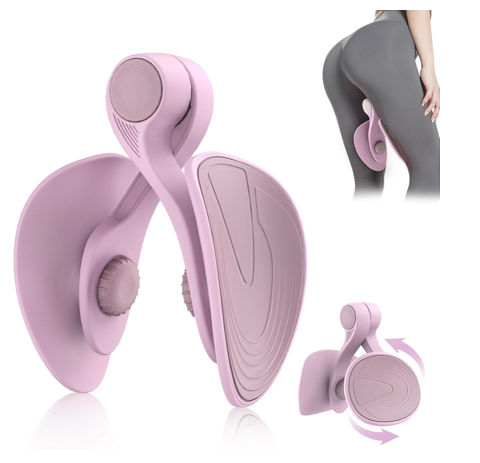
The TINRIEF hip trainer and Kegel exerciser is a dual-function fitness device that combines pelvic floor strengthening with inner-thigh toning, making it especially useful for postpartum rehabilitation.
With compact design and balanced resistance, it helps activate key muscles for bladder control, hip shaping and core engagement all from the comfort of your home.
Features
- Weighs 0.72 kilograms
- 0 soft silicone joint
- Versatile muscle engagement
- Ergonomic and portable design
- 16 kg (≈ 35 lb.) dual-action resistance
Pros
- No electronics needed
- Has comfortable joint design
- Lightweight and compact
- Supports pelvic recovery
- Has good resistance range
- Easy to store or take with you
- It lifts buttocks and simplifies Kegel exercise routines
Cons
- Not Biofeedback-Based
Who Needs Best Compact Pelvic Floor Exercisers
The following may need the best compact pelvic floor exercisers;
- People with Urinary Incontinence: Those experiencing bladder leaks from coughing, sneezing, or sudden urges can benefit.
- Postpartum Mothers: Pregnancy and childbirth can weaken pelvic muscles; compact trainers offer a convenient way to rebuild strength.
- Older Adults: Muscle tone naturally declines with age and both men and women may use pelvic trainers to maintain control.
- Men Recovering from Prostate or Pelvic Surgery: Kegel exercises help men regain urinary and bowel control after prostate procedures.
- Athletes & Active Individuals: Especially useful for people who lift weights or do high‑impact sports since training the pelvic floor helps prevent stress leaks.
- People Looking to Improve Sexual Function: A stronger pelvic floor can enhance sexual sensation, improve orgasm and support better pelvic stability.
- Those Without Access to Pelvic Floor Therapy: Compact trainers offer a budget-friendly, home-based way to do Kegel training when physical therapy isn’t an option.
Types Of Pelvic Floor Exercisers
This includes;
a. Biofeedback (Smart) Trainers
-
- These use internal or external sensors to measure your pelvic floor contractions and send real-time feedback via a gauge, app, or visual display.
- Subtypes include pressure biofeedback (perineometers), EMG biofeedback (electrical activity), and Bluetooth devices that connect to smartphone apps.
- Best for: people who want guidance, measurable progress, and accountability.
b. Weighted (Manual) Trainers
-
- These are simple, non-electronic devices (like silicone cones, “Ben Wa” balls, or Kegel eggs) that you insert and then hold with your pelvic muscles.
- Best for: users who prefer a low-tech, tactile workout and can already isolate their pelvic floor muscles.
c. Electrical Stimulation / EMS Devices
-
- These use low-level electrical pulses (NMES / EMS) delivered via internal probes or external pads to stimulate pelvic muscles to contract.
- Helpful when voluntary contractions are difficult (e.g., very weak pelvic floor or after surgery).
d. External Stimulation / Non‑Invasive Devices
-
- These don’t require internal probes. Instead, they may use pads or wearable garments to stimulate or train muscles from outside the body.
- Best for: users who want to avoid internal insertion or prefer less invasive stimulation.
e. Resistance or “Weight” Training Devices
-
- These are similar to weighted trainers but use mechanical resistance (springs, adjustable tension) instead of just passive weight.
- They add resistance to your pelvic floor exercise, making your muscles work harder.
- Best for: people who want progressive strength training (like a gym for the pelvic floor).
FAQs For Best Compact Pelvic Floor Exercisers
How do I clean the device?
Use warm water and mild soap or an approved toy cleaner. Avoid harsh chemicals that can degrade silicone or plastics.
Can men use compact pelvic floor exercisers?
Yes. Some devices are unisex, while others are specifically designed for women. Men often use biofeedback or EMS-based trainers.
How long until I see results?
With consistent use, improvements in bladder control or muscle tone typically appear in 4–8 weeks.
Are these devices safe for everyone?
Generally, yes, but people with pelvic pain, infections, or recent surgery should consult a doctor first.
How long should I use it daily?
Most experts recommend 5–15 minutes per day, depending on the device and exercise program.
Conclusion
In conclusion, the best compact pelvic floor exercisers offer a convenient, effective way to strengthen pelvic muscles, improve bladder control and support postpartum or post-surgery recovery.
Choosing the right device depends on your comfort, resistance level and whether you want app-guided guidance.
Consistent use can lead to noticeable improvements in pelvic strength, core stability and overall confidence , making these compact trainers a smart, long-term investment in your pelvic health.

